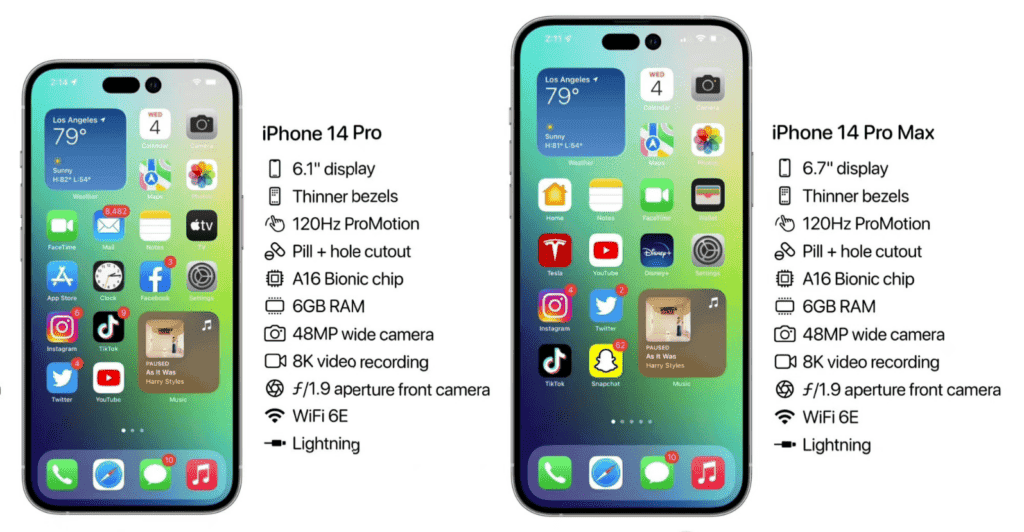Apple is expected to release the new iPhone 14 series this fall. The iPhone 14 standard version and iPhone 14 Max will use the A15 chip, while the iPhone 14 Pro and iPhone 14 Pro Max models will use the A16 chip. So the iPhone 14 Pro will perform much better than the iPhone 14 standard version. Now Macworld has come up with performance predictions for the iPhone 14 Pro, all compared to the iPhone 13 Pro. First of all, the prediction is that, in terms of the chip manufacturing process, this latest chip will use the third-generation 5nm process from TSMC (N4P). This brings some relatively modest performance gains.

Comparing this manufacturing process to the older 5nm “N5” manufacturing process, N4P offers an 11% performance increase. This new manufacturing process also offers a 22% energy efficiency increase as well as a 6% density increase. From these predictions, the iPhone 14 Pro will obviously get a faster memory. Back in March, analysts claims the iPhone 14 Pro models would upgrade from LPDDR4 to LPDDR5 (6GB). This is the faster memory Apple uses in the M1 Pro and M1 Max chips. At the time, a couple of authorities in the smartphone tech space agrees with the claim.
“There should be increased memory bandwidth, among other improvements, which, combined with higher peak clock speeds, could give Apple chips up to 15 percent better performance.”
iPhone 14 Pro GPU performance will also increase
Macworld discussed the possibility of ARMv9 support but didn’t think it would have much impact. In terms of GPU performance, there will be potential additional cores, architectural improvements and faster memory access.
“We think it ’s reasonable to expect a 25% to 30% increase in GPU performance. This is roughly on par with recent A-series processors. You’ll see this in current benchmarks and tests that are limited by memory bandwidth. “
The iPhone 14 Pro is expected to require enhanced processor performance: an upgrade to a 48-megapixel camera sensor that supports 8K video capture. Earlier, Ming-Chi Kuo claims that the main camera uses a 48MP sensor. As such, Macworld expects that most of the extra performance will focus on image processing and artificial intelligence.
“It’s not simply loading a 48MP sensor. There has to be a wider, faster data path to the image signal processor. The image processor has to be able to process four times as many pixels (or take four times as long to process the image – given that Apple priority on camera responsiveness, which is unlikely)…
In other words, this new camera may require a more powerful image signal processor and neural engine (dedicated hardware for artificial intelligence and machine learning tasks). We’re sure Apple would love to improve the Cinema mode which hit the public with the iPhone 13 Pro. For example, it’s current limit is 1080p shooting, but stepping up to 4K shooting requires more image processing power. The same goes for more natural AI bokeh or multi-object tracking. There’s a good reason why Apple is serious about beefing up its graphics processor and Neural Engine. “
Component suppliers will get more orders
Ming-Chi Kuo claims that many high-end component suppliers for the rear camera will benefit significantly. They will benefit from the significant increase in the proportion of high-end iPhone 14 models. Some of the beneficiaries will be Sony (CIS), Largan (lens), Alps (VCM / OIS) and LG Innotek (CCM). Benefiting from the increase in shipments of high-end models of iPhone 14, the output value of rear CIS, lens, VCM/OIS and CCM of iPhone 14 will also increase significantly by 30–35%, 20–25%, 15–20% and 30–35% year-on-year, respectively. Excluding low-specification ToF, the shipment share of major iPhone 14 Pro rear camera component suppliers will increase. Sony (CIS), Largan (lens), Alps (VCM / OIS) and LG Innotek (CCM) will get 100%, 60–70%, 60–70%, and 100%, respectively.
Below is another area that will benefit from greater memory bandwidth.
“The transition from LPDDR4x to LPDDR5 will increase memory bandwidth by up to 50%. It will also have a positive impact on energy efficiency. This by itself does not make any task faster, it just provides high bandwidth for things like 3D graphics and image/video processing…”




